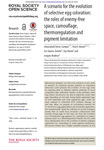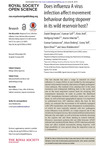Search
Now showing items 31-40 of 57
A scenario for the evolution of selective egg coloration
(2016)
Behavioural plasticity can drive the evolution of new traits in animals. In oviparous species, plasticity in oviposition behaviour could promote the evolution of new egg traits by exposing them to different selective ...
Conflict between background matching and social signalling in a colour-changing freshwater fish
(2016)
The ability to change coloration allows animals to modify their patterning to suit a specific function. Many freshwater fishes, for example, can appear cryptic by altering the dispersion of melanin pigment in the skin to ...
Deceived by stripes
(2016)
Conspicuous coloration, which presumably makes prey more visible to predators, has intrigued researchers for long. Contrastingly coloured, conspicuous striped patterns are common among lizards and other animals, but their ...
Brain serotonergic activation in growth-stunted farmed salmon
(2016)
Signalling systems activated under stress are highly conserved, suggesting adaptive effects of their function. Pathologies arising from continued activation of such systems may represent a mismatch between evolutionary ...
Coevolutionary interactions between farmers andmafia induce host acceptance of avian brood parasites
(2016)
Brood parasites exploit their host in order to increase their own fitness. Typically, this results in an arms race between parasite trickery and host defence. Thus, it is puzzling to observe hosts that accept parasitism ...
Multiple behavioural morphological and cognitive developmental changes arise froma single alteration
(2016)
Subtle variations in early rearing environment influence morphological, cognitive and behavioural processes that together impact on adult fitness. We manipulated habitat complexity experienced by young pheasants (Phasianus ...
Does influenza A virus infection affect movement behaviour during stopover in its wild reservoir host?
(2016)
The last decade has seen a surge in research on avian influenza A viruses (IAVs), in part fuelled by the emergence, spread and potential zoonotic importance of highly pathogenic virus subtypes. The mallard (Anas platyrhynchos) ...
Post copulatory opportunities for sperm competition and cryptic female choice provide no off spring fitness benefits in externally fertilizing salmon
(2016)
There is increasing evidence that females can somehow improve their offspring fitness by mating with multiple males, but we understand little about the exact stage(s) at which such benefits are gained. Here, we measure ...
To boldly climb: behavioural and cognitive differences in migrating European glass eels
(2016)
European eel (Anguilla anguilla) is a catadromous fish species that received substantial attention as its population has markedly declined in the last three decades. The possible causes of this decline include habitat ...
Social familiarity affects Comparative phylogenetic analyses uncover the ancient roots of Indo European folktales
(2016)
Ancient population expansions and dispersals often leave enduring signatures in the cultural traditions of their descendants, as well as in their genes and languages. The international folktale record has long been regarded ...










